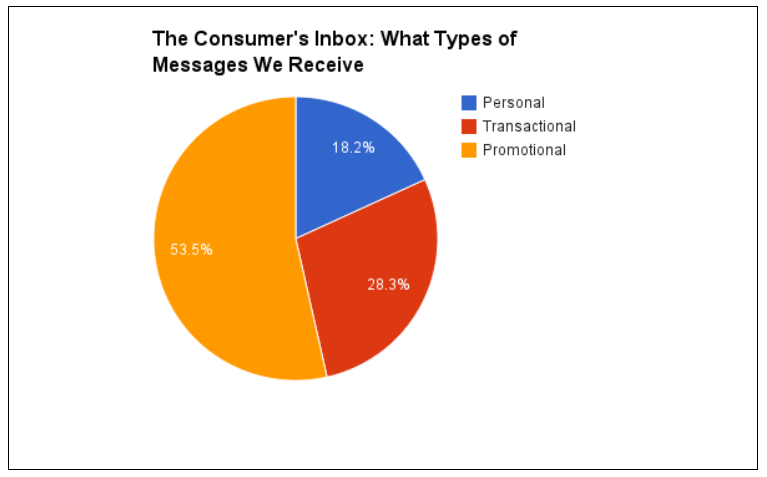80% of the world’s population is using social media. That’s a BIG number, but there’s a lot more beneath its surface.
Nearly every single person comprising that 80% has an active email account, too.
In fact, “there are 3x more email accounts than there are Facebook & Twitter accounts combined,” says Campaign Monitor. That’s important from a marketing perspective; email consistently yields higher engagement and response rates than social media.
We’ve already offered tips for sending better emails, crafting well-structured newsletters, and building the perfect email list. Today, we’re doing things a little differently.
Let’s talk about spam.
What is spam?
No one likes spam. All it’s good for is clogging your inbox. That’s disgusting.
Spam refers to unsolicited email that’s sent to recipients in bulk. Unsolicited emails are messages that recipients do not explicitly opt into receiving. Basically, they’re sent to your inbox without your permission.
Right?
Spam emails have proliferated in the last decade and continue to pose problems for email users. But how exactly do they arrive in your inbox? Your email ID is usually obtained by spambots — automated programs that crawl the internet for hapless victims (i.e. email addresses).
Promotional emails are by far the most common type of spam, followed by transactional and personal.

Source: Return Path
The importance of reputation in email marketing
When it comes to email marketing, your sending reputation can have a marked impact on your campaign’s success. By being proactive and tracking important engagement (opens, clicks, click-through rates) and reputation (spam complaints, unsubscribes, etc.) metrics, you’ll paint a clearer picture of your emails’ deliverability.
The reputation of your email account is determined by servers that evaluate your actions. Things like deliverability, interactions, opt-outs, and spam complaints all factor into your overall reputation. An excellent or poor reputation determines how your recipient’s email server processes your sent emails.
A poor reputation can tank your open rate because the recipient’s server will likely flag your emails as spam. A great reputation, however, can boost your ROI and ensure your messages are consistently delivered.
Anti-spam requirements for email campaigns: what the laws say
If you’re a business that’s already using emails to promote your services, there are a number of laws you must abide by. Failure to do so may spell disaster for your company.
These regulations ensure that commercial businesses remain transparent and responsible when handling customers’ personal data. They include the CAN-SPAM Act in the U.S., the CASL in Canada, and the EU GDPR.
We’ve summarized the key takeaways from each law below.
Key Compliance Guidelines for Email Marketing: Understanding CAN-SPAM, CASL, and GDPR
From the CAN-SPAM Act:
-
Don’t use false or misleading header information
-
Don’t use deceptive subject lines
-
Identify the message as an ad
-
Tell recipients where you’re located
-
Tell recipients how to opt out of receiving future emails from you
-
Honor opt-out requests promptly
-
Monitor what others are doing on your behalf
From CASL:
This anti-spam law stipulates that “there are three general requirements for sending a commercial electronic message (CEM) to an electronic address: (1) obtain consent, (2) provide identification information, and (3) provide an unsubscribe mechanism.”
Two types of consent are outlined under CASL: express and implied. Express consent doesn’t expire, but the recipient can withdraw it at any time.
From the EU General Data Protection Regulation (GDPR):
The GDPR is considered the most important change in data privacy regulations in the past 20 years (source).
Although these measures apply more broadly to data integrity and protection (they’re technically data and privacy laws, not email laws), they can still impact your email marketing initiatives. Here’s what the GDPR entails:
-
Requiring the consent of the data subject for data processing
-
Anonymizing collected data for privacy protection
-
Notifying subjects of data breaches
-
Safely and responsibly handling data transfers
-
Necessitating certain companies to assign a data protection officer for compliance oversight
Practical tips for keeping your emails out of spam folders
Navigate around those pesky spam traps with these helpful tips:
-
Don’t get “send-happy.” If you’re a business, you’re probably thinking about your customers all the time. But your customers aren’t doing the same (sorry). They’re busy, and the last thing they want is to hear from you every single day. Limit your emails to once a week. Start from there, then gauge how often your subscribers prefer receiving messages.
-
Build a healthy email list. Doing so requires permission from your subscribers. If you don’t get it, your marketing campaigns won’t work.
-
On that note, go with the double opt-in. You’ll know for sure if your subscribers are authentic, and your emails won’t be marked as spam.
-
Switch up your email’s content and structure. Sending the same message every week isn’t a great idea. Keep things fresh and avoid using spam trigger words like these.
-
Have a clear, attainable goal and stick to it. Having too many will detract from your overall message. You’ll lose focus and end up creating useless emails that don’t serve a purpose. Create messages that are relevant to your subscribers’ needs (relevance is the key to avoiding spam filters; check out the graph below).
-
Have a consistent (and legit) “from” field address. A verifiable sender address builds trust with your audience. Having more than one looks pretty suspicious and your emails could be marked as spam. Avoid cookie-cutter choices like donotreply@hummusloversunite.com.
-
No tricks! More than 50% of consumers felt cheated into opening a promo email. Don’t be “that guy.” Your email list will die quickly and your reputation will be tarnished forever.
-
Pay attention to your subject lines. Around 70% of emails are flagged as spam because of their subject lines. For best results, limit them to 20 characters. And make sure YOU’RE NOT SCREAMING LIKE THIS ALL THE TIME. Here’s why.
-
Never buy email lists. It’s technically a violation of the CAN-SPAM Act.
-
Test your emails before you send them. Tools like Mail Tester can help.
Try Joomag’s email marketing tool!
Joomag’s all-in-one digital publishing and content experience platform offers the best tools to help you create the perfect email marketing campaign. It features:
-
Templates for quick and easy email creation (plus custom template coding)
-
List management & segmentation via Joomag’s built-in CRM
-
Complete email campaign management tools (create, launch, and track your campaigns from one platform)
For more in-depth information on Joomag’s email marketing services, click here.
FAQ
Q1: What makes email marketing stand out compared to social media?
A1: Email marketing outperforms social media due to its wider reach—there are three times more email accounts than Facebook and Twitter combined. The direct nature of email ensures higher engagement rates, making it a crucial channel for marketers aiming for impactful communication.
Q2: How does spam impact email marketing efforts?
A2: Spam, or unwanted bulk email, can significantly hinder email marketing by risking messages being filtered out by spam filters. Marketers must maintain a positive sending reputation and adhere to email laws like CAN-SPAM, CASL, and GDPR to ensure their emails reach their intended audience without being marked as spam.
Q3: What strategies can improve email marketing and reduce spam risks?
A3: To enhance email marketing and minimize spam risks, businesses should focus on permission-based email lists, use double opt-in mechanisms, vary content to keep it fresh, and set clear, relevant goals for each campaign. Additionally, accurate sender information and testing emails before sending are crucial for avoiding spam filters and maintaining engagement with the audience.
















